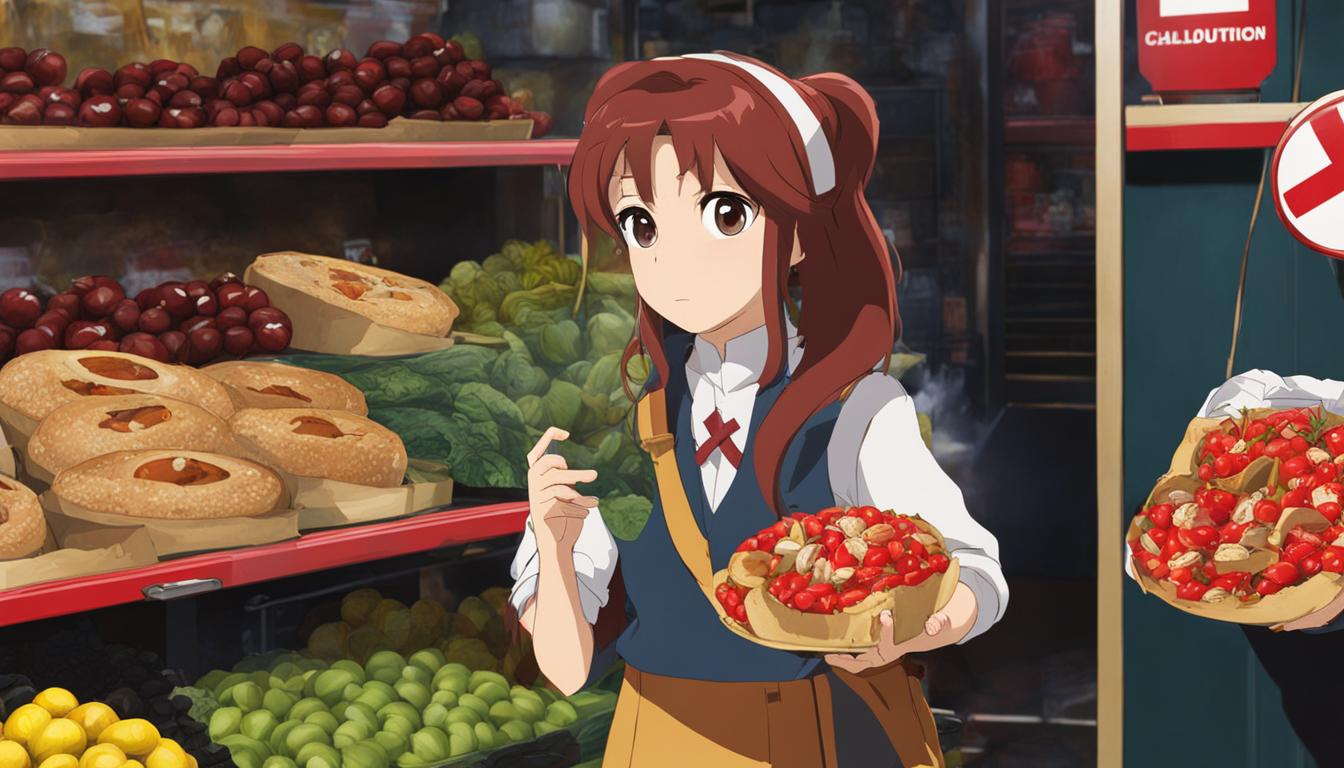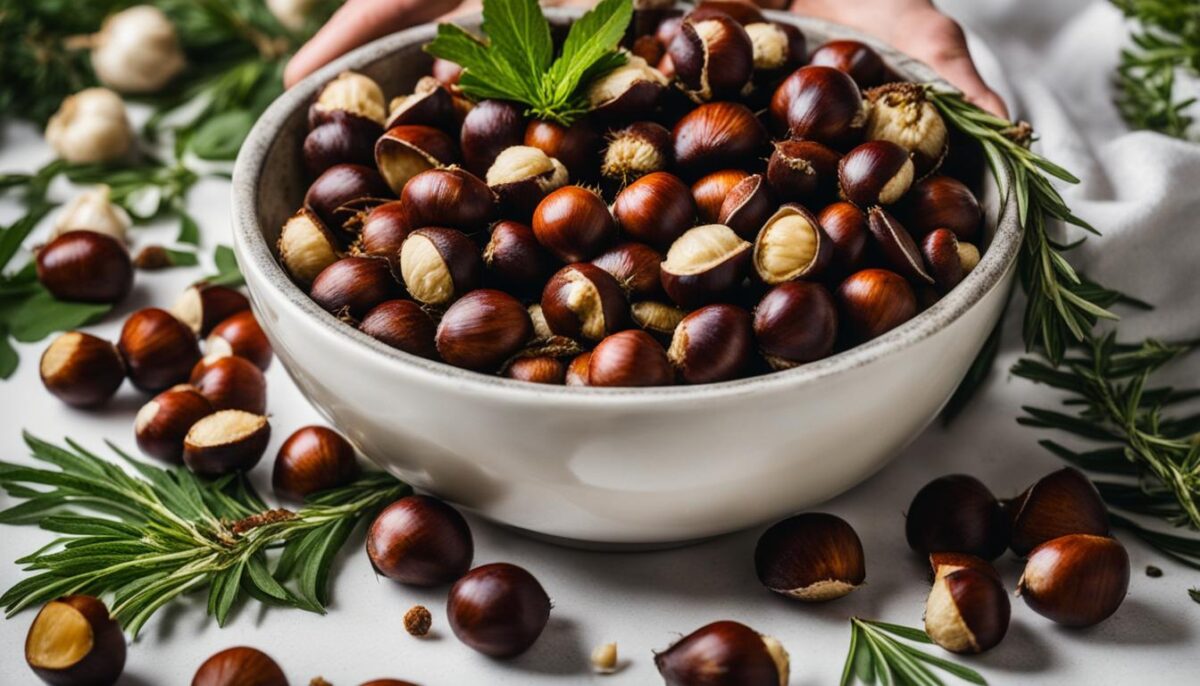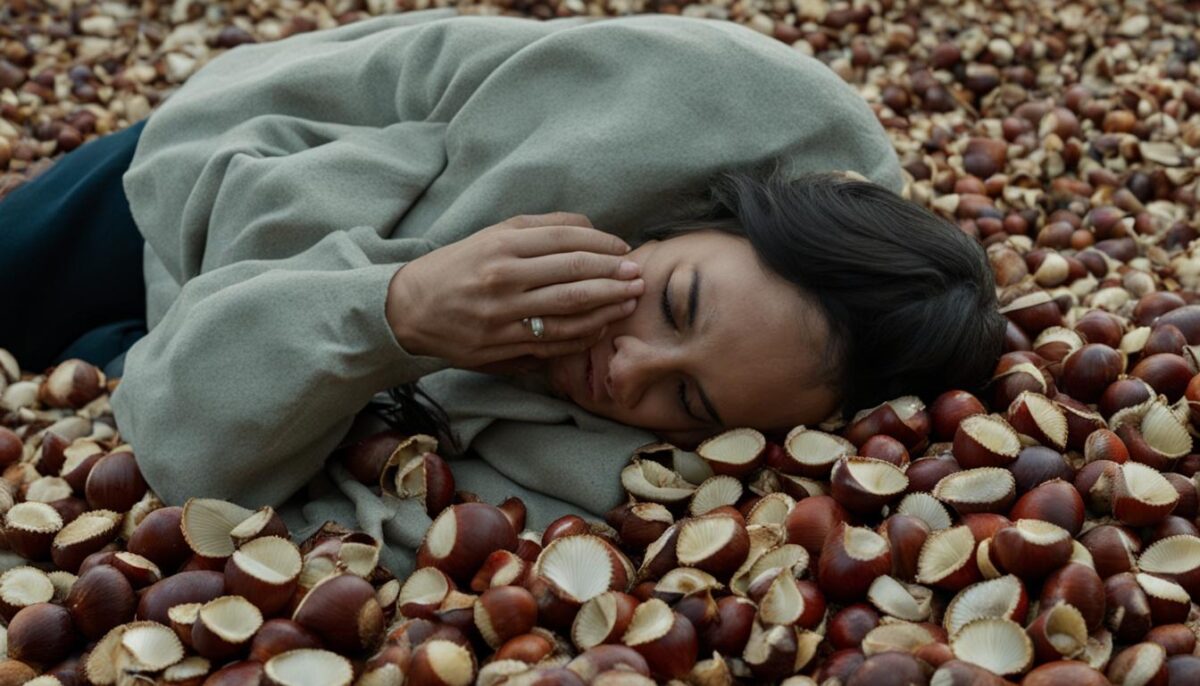Hey there! If you find a nut that looks like a chestnut, you need to be careful. Some nuts that look like ones you can eat are actually horse chestnuts, and you really shouldn’t eat them. Horse chestnuts come from a tree named Aesculus hippocastanum. They look a little like other chestnuts, but they’re not the same.
Can you eat horse chestnuts? No, it’s not safe. These nuts have a big white spot and are round and smooth. They can make you feel sick with an upset stomach or worse. So, it’s really important to know about horse chestnut safety. Always make sure what you’re picking up is safe to eat, and if you’re not sure, don’t eat it!
If you or someone you know accidentally eats horse chestnut, it’s best to call Poison Control at 1-800-222-1222 right away. They can tell you what to do to be safe and feel better.
Key Takeaways
- Horse chestnuts can’t be eaten—they could make you sick.
- Real chestnuts and horse chestnuts look different, so look closely.
- If someone eats a horse chestnut by mistake, clean their mouth and sip water.
- Always call Poison Control at 1-800-222-1222 if you eat a horse chestnut.
- Remember, for horse chestnut consumption, safety is most important. When in doubt, don’t eat it!
Understanding Horse Chestnut Trees and Their Fruit
Do you know about horse chestnut trees? They’re not like other trees. You can’t eat the nuts they make. Let’s find out why and learn what makes them different from the chestnuts we eat.
Characteristics of Horse Chestnuts versus Edible Chestnuts
Horse chestnut trees have big leaves that look like hands with fingers. In the spring, they have pretty flowers that can be white or pink. When the flowers are done, they grow green pods that are spiky. Inside these pods, there’s usually just one nut. These nuts are big and shiny and have a spot that looks a bit like a belly button! But unlike edible horse chestnuts, you shouldn’t eat these nuts. They can make you feel very sick because they have something poisonous inside called saponin aesculin.
Edible chestnuts, on the other hand, grow in a different kind of spiky pod that has lots of sharp points. These pods usually have more than one nut inside. Also, the nuts you can eat have a point on one end, kind of like they have a little tail.
Here’s a table that shows you more about how horse chestnut trees and their fruit are different from the kinds of chestnuts we can eat.
| Feature | Horse Chestnut | Edible Chestnut |
|---|---|---|
| Pod Appearance | Spiky but spaced out | Very spiky and dense |
| Nut Count | Usually one nut per pod | Several nuts per pod |
| Nut Shape | Round with a pale spot | Pointed end (tail) |
| Nut Taste | Bitter (poison!) | Starchy and sweet |
| Toxin Presence | Saponin Aesculin | None (safe to eat) |
Geographical Origins of the Horse Chestnut Tree
The horse chestnut tree isn’t from around here. It came from far away, across the ocean in a place called the Balkans in Europe. A long time ago, people thought these trees were so beautiful that they brought them to America. Now they’re all over the place because they make nice shade with their big leafy hands. But remember, no matter how nice they look, we should never eat the nuts or leaves from these trees because of the nutritional value of horse chestnuts is not good for us or animals—it’s actually harmful.
Can You Eat Horse Chestnuts? Debunking Common Myths
Are you wondering about horse chestnut recipes and the health benefits of horse chestnuts? You might hear about chestnuts during the holidays and think all chestnuts can be eaten. This is not right! The truth is, horse chestnuts are **not safe to eat** at all.
Why can’t you eat horse chestnuts? Well, they have something inside called **saponin aesculin**. This is a big word that means they can upset your stomach and make you feel really sick. It’s a big mistake to think you can cook with horse chestnuts like other nuts. Unlike the yummy chestnuts we eat, horse chestnuts don’t have the **health benefits** of other nuts.
Did you know the good kind of chestnuts have vitamin C and not too much fat? That’s why we like them and they help us feel good. But, horse chestnuts don’t have these good things. So, when you see chestnuts, remember not all of them are okay to eat. Always pick the right kind!
It’s sad but there are no real horse chestnut recipes because they are not safe. You might think they look okay, but eating them is not good!
Remember, if you’re not sure, it’s best not to eat it. Be safe and keep smiling!
- Horse chestnuts cannot be eaten.
- The nuts with white spots are not for eating.
- There are no health benefits of horse chestnuts when you eat them.
- For safe holiday fun, only roast the good kind of chestnuts.
Horse Chestnut Toxicity: What Happens If You Ingest Them?
When you see a horse chestnut, you might think it’s okay to eat. But it’s not. These nuts can make you feel very sick. If you eat them, you might get a sore stomach and start to feel like throwing up.
Potential Symptoms of Horse Chestnut Poisoning
Some of the things that might happen if you eat horse chestnuts include feeling weak, having trouble walking, getting very sleepy, and not being able to move well. You might also feel your muscles jumping around without you trying to move them. The worst thing is when your belly hurts a lot.
Case Reports: Real Incidents of Horse Chestnut Consumption
There have been real times when people ate horse chestnuts and got sick. Like one time, a man cooked and ate four of them. Then his stomach started to hurt. He realized he needed help, so he called Poison Control. They told him what to do, and after drinking water and waiting, he felt better. Another time, a mom and her son each tried one nut they thought was good to eat. It tasted bad, so they spit it out. They called Poison Control too, and after drinking some fluids, they were fine. These stories remind us to be careful with what we eat, especially when it comes to horse chestnuts.
Navigating the Risks: Prevention and First Aid for Exposure
Let’s talk about how to keep safe when we’re around horse chestnuts. We want to play and explore without worrying. So, here are some smart ideas to stay away from horse chestnut risks and what to do if someone has eaten them.
Preventive Measures to Protect Children and Pets
Little ones and our furry friends are curious. They might pick up things they shouldn’t eat. Horse chestnuts are one of those things we keep away from. You can look at them, but don’t let them go in your mouth! Always remember:
- Never let kids and pets eat stuff from the ground, especially fallen seed pods.
- Know what your plants are. It’s just like knowing your friends!
- Ask a plant expert before eating any wild plants or seeds.
- Joining a plant picking club can be fun and you’ll learn what’s safe.
Your safest bet is to enjoy plants and seeds with your eyes, not your mouth, unless you’re really sure it’s okay.
Guidelines for Immediate Response Post-Ingestion
What if somebody accidentally eats a horse chestnut? Stay calm! Here’s what you can do to help:
- Clean their mouth out gently with a cloth.
- Swish and spit water to get rid of any bits left.
- Drink a tiny bit of water. It helps get anything else down to the tummy.
- If they feel like throwing up, sip a little water slowly to stay hydrated.
If you’re worried or don’t know what to do, call for help! Poison Control’s number is 1-800-222-1222. They are there to tell you what to do next.
And remember, learning the safe ways to prepare horse chestnuts and knowing horse chestnut consumption prevention tips are smart moves to make sure everyone is safe!
Edible Versus Inedible: Identifying Safe Chestnuts
Now, let’s chat about how you can spot the right chestnuts to eat. It’s kind of like a treasure hunt, but for food! When you’re outside or shopping for chestnuts, remember you’re looking for the good kind. And you’ll need to know one from the other – it’s important!
Visual Differences Between Horse Chestnuts and Edible Varieties
Edible chestnuts have a prickly outfit – a spiky cover! They also have what looks like a little hat or pointy end, called a tassel. When you give them a gentle squeeze, they feel a bit soft but still tough. However, those round ones, with a smooth shell and a spot? Those are horse chestnuts! They may look nice, but they are not your friends when it comes to eating. They’re not the chestnuts you sing about during holiday songs. Keep these visual tips in mind for identifying safe chestnuts!
Safe Foraging Practices for Chestnuts
If you love discovering foods outside, it’s cool to go foraging – that’s when you search for food like nuts and berries! Here are easy guidelines for chestnut foraging: Only pick chestnuts that match what we talked about, with the spiky cover and pointy hat. If you’re not sure, it’s better to leave it be. When you’re in a store or at a farmer’s market, look for chestnuts kept in a chilly place but not frozen. It’s like they have been tucked in a cozy fridge bed, just right – not too cold, not too warm. If you grab chestnuts to take home, treat them well! Put them in your fridge in a bag with some holes poked in it – they like to breathe too. This keeps them yummy and ready for your tasty chestnut adventures!
FAQ
Can you eat horse chestnuts?
No, horse chestnuts are not edible and are considered toxic. Eating horse chestnuts can cause nausea, vomiting, diarrhea, and even severe symptoms such as difficulty breathing or paralysis. Always avoid consuming horse chestnuts.
What are the characteristics of horse chestnuts versus edible chestnuts?
Horse chestnuts are generally round with a smooth surface and a characteristic pale spot. They typically come in a spiky green husk with only one nut inside. Edible chestnuts, on the other hand, have a pointy tip and are found in a spiky husk that often contains multiple nuts.
Where do horse chestnut trees originally come from?
Horse chestnut trees, scientific name Aesculus hippocastanum, originate from the Balkan region of Southeast Europe. They have been introduced to many other parts of the world as ornamental trees.
Are there any health benefits to horse chestnuts?
While horse chestnuts contain compounds that may provide benefits when used in creams or other topical applications for vascular health, they do not provide health benefits when eaten due to their toxicity.
What should you do if someone ingests horse chestnuts?
If someone ingests horse chestnuts, they should rinse their mouth and drink some water to remove any remaining particles. Seek immediate medical attention by calling Poison Control at 1-800-222-1222 and follow their instructions.
What are some symptoms of horse chestnut poisoning?
Symptoms of horse chestnut poisoning can include stomach pain, vomiting, diarrhea, dizziness, weakness, and in severe cases, difficulty in breathing or even paralysis.
How can you prevent horse chestnut poisoning in children and pets?
Keep horse chestnut trees and fallen nuts or seed pods out of reach of children and pets. Teach children not to eat any nuts or seeds they find outdoors and supervise pets while outside.
What are the first steps to take if you have been exposed to horse chestnuts?
First, remove any residual nuts or pieces from the mouth, then rinse and spit out using water. Drink small sips of water and seek medical attention immediately, especially if symptoms develop.
How can you safely identify edible chestnuts?
Edible chestnuts have a distinctive spiky husk and a pointy tip on the nuts. They usually feel slightly soft when squeezed. Avoid round, smooth nuts with a pale spot, as those are likely horse chestnuts.
What should you keep in mind when foraging for chestnuts?
When foraging for chestnuts, make sure to correctly identify that they are the edible variety. It helps to go foraging with a knowledgeable guide, and remember to cure the nuts properly by storing them at a cool temperature before consuming.


